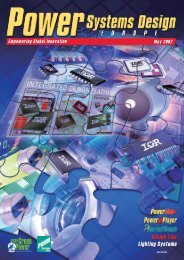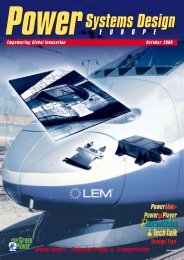Testing Virtual ECUs - Power Systems Design
Testing Virtual ECUs - Power Systems Design
Testing Virtual ECUs - Power Systems Design
You also want an ePaper? Increase the reach of your titles
YUMPU automatically turns print PDFs into web optimized ePapers that Google loves.
30<br />
SPECIAL REPORT : AUTOMOTIVE ELECTRONICS<br />
POWER PACKAGING<br />
The gatekeeper of performance<br />
By Benjamin Jackson<br />
The 2011 automotive year started with the Detroit Auto show<br />
where the new Chrysler 300 was launched, its headline, a 3.6l<br />
V6 engine delivering a whopping 292 hp (218 kW), 41 hp (31<br />
kW) more than the previous model year of the same car.<br />
Of course it will come<br />
as no surprise to<br />
learn that the old<br />
model was a smaller<br />
engine with a displacement of 3.5<br />
Litres compared to the new 3.6<br />
Litres. But what is surprising is<br />
that despite having a bigger, more<br />
powerful engine, the new vehicle<br />
delivers an 8% improvement in<br />
fuel economy over its predecessor.<br />
In a similar manner Ford announced<br />
that from 2012 its Escape/Kuga<br />
models will feature<br />
start-stop technology delivering<br />
a 10% improvement in efficiency.<br />
Meanwhile Hyundai Mobis debuted<br />
their new Gamma 1.6l<br />
engine, their smallest gasoline<br />
engine to feature direct injection (a<br />
technology traditionally limited to<br />
diesel cars) which they claim will<br />
deliver fuel economy of 40 mpg<br />
fractionally better than the 39 mph<br />
boasted by the new hybrid Honda<br />
CR-Z.<br />
The rapidly rising gasoline prices<br />
over the last few months clearly are<br />
making consumers hungry for fuel<br />
efficient cars.<br />
But perhaps<br />
more significant<br />
in driving the<br />
eco-car trend is<br />
that car manufactures<br />
need<br />
to sell more<br />
fuel efficient<br />
cars. A swathe<br />
of increasingly<br />
stringent emissionsregulations<br />
is forcing car manufactures<br />
to release more fuel efficient cars<br />
and in some parts of the world<br />
they risk loosing profitability if they<br />
do not step up to the challenge. In<br />
Europe from 2012 car manufacturers<br />
will be fined if the average CO2<br />
emissions of the new cars sold<br />
is more than a certain threshold.<br />
In the near term fines will be significant<br />
at around 5 - 15€ for every<br />
gram of CO2 per vehicle over the<br />
target, however this seems modest<br />
when compared to the alarmingly<br />
high 95€ per gram over target fine<br />
that will be imposed from 2019<br />
onwards! Clearly fuel efficiency is<br />
not just fashionable; it is going to<br />
Figure 1: The Die Free package resistances of different<br />
power semiconductor packages<br />
make business sense.<br />
One way to improve fuel economy<br />
and emissions is to move to hybrid<br />
and fully electric topologies.<br />
But the dominance of the internal<br />
combustion engine is unquestionably<br />
strong and for good reason.<br />
There is a highly establish refueling<br />
infrastructure, a refined and<br />
experienced servicing and repair<br />
network, the technology is well<br />
understood and relatively cheap to<br />
mass produce. But gasoline and<br />
the internal combustion engine<br />
also has another strength: power<br />
density. A car can only be so big<br />
or so heavy, with gasoline having<br />
an energy density of 45MJ/kg compared<br />
to 0.1MJ/Kg for a lead acid<br />
battery it is easy to see why a gasoline<br />
internal combustion engine<br />
makes such a compelling source<br />
of power for a car. To this end car<br />
manufactures are making improvements<br />
to this traditional power<br />
source to improve efficiency and<br />
system needing power semiconductors<br />
like electric fuel pumps,<br />
fuel injection and electric power<br />
steering are being widely adopted.<br />
With efficiency being a driving<br />
actor semiconductor companies<br />
need to continually offer better<br />
performance and traditionally<br />
the biggest challenge to advancing<br />
performance has been the<br />
semiconductor itself. But as the<br />
silicon becomes better we need to<br />
consider the rest of the chain and<br />
in particular the package which<br />
houses the silicon.<br />
A simple figure of merit when<br />
considering MOSFETs is the<br />
RDS(ON), a parameter which directly<br />
impacts the conduction losses<br />
of the system and ultimately its<br />
efficiency. This single value on the<br />
data sheet is comprised of two values,<br />
firstly the on resistance of the<br />
MOSFET die and secondly the resistance<br />
of the package, summed<br />
together these give the stated<br />
RDS(ON). In a D2Pak the package<br />
resistance can be as high as<br />
0.5mOhm, this does not sound a<br />
lot, but considering that a state-ofthe-art<br />
40V MOSFET would have<br />
an RDS(ON) of around 1mOhm,<br />
its impressionable that around<br />
50% of the RDS(ON) can be attrib-<br />
Figure 2a: Traditional TO-262<br />
package<br />
uted solely to the package.<br />
To combat this various packages<br />
have been developed, one the<br />
more established being the Direct-<br />
FET form International Rectifier<br />
which has a package resistance<br />
of around 150µOhm, or 70% less<br />
than a D2Pak (see figure 1).<br />
Clearly, as semiconductor performance<br />
becomes increasingly<br />
better, the role that the package<br />
plays becomes more and more<br />
important. We must not forget<br />
that the package is a series element<br />
in the system; all of the current<br />
must flow through the package<br />
and heat generated inside<br />
must flow out unrestricted. With<br />
the advent of high performance<br />
surface mount packages like the<br />
DirectFET system manufacturers<br />
can achieve higher power densities<br />
with the convenience of SMD<br />
manufacturing and assembly. But<br />
in some very high power systems<br />
there is still a need or indeed a<br />
preference for through-hole assemblies.<br />
Considering this and<br />
the fundamental values of Direct-<br />
FET, International Rectifier took a<br />
fresh look at the established longleaded<br />
cousin of the D2Pak, the<br />
POWER SYSTEMS DESIGN JULY/AUGUST 2011<br />
Figure 2b: New Wide Lead TO-262<br />
package<br />
TO-262 (figure 2a).<br />
It is not widely known that on the<br />
TO-262 package that the leads add<br />
significant resistance in addition<br />
to the RDS(ON) of the device. In<br />
fact the drain and source leads of<br />
a typical TO-262 have a total resistance<br />
of just under 1mOhm. Many<br />
years ago when the RDS(ON) of<br />
a MOSFET was in the 10mOhm<br />
range 1mOhm of extra resistance<br />
on the leads was insignificant. Today<br />
given improvements in silicon<br />
technology a 1 or 2mOhm MOS-<br />
FET in a TO-262 is to be expected,<br />
so 1mOhm of lead resistance suddenly<br />
becomes very significant in<br />
the total drain to source on resistance<br />
of the device.<br />
With an aim to improve the efficiency<br />
of the TO-262 package International<br />
Rectifier has developed<br />
and recently released the new<br />
WideLead TO-262 package. In<br />
terms of dimensions this package<br />
is identical to the traditional TO-<br />
262, but the leads are significantly<br />
wider. This has the benefit of<br />
reducing the total drain and source<br />
lead resistance from just under<br />
1mOhm to around 0.5mOhm.<br />
Furthermore by enhancing the wire<br />
WWW.POWERSYSTEMSDESIGN.COM WWW.POWERSYSTEMSDESIGN.COM<br />
31









